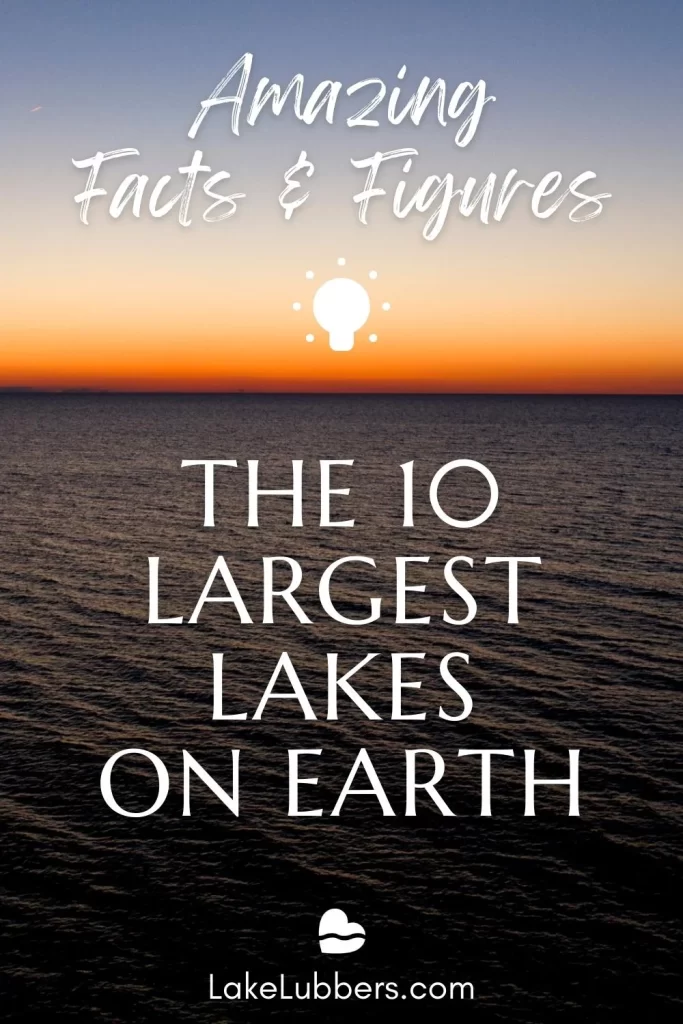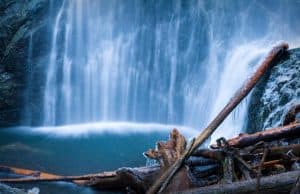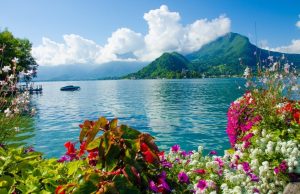This post contains affiliate links. If you click and purchase, we may earn a small referral fee at no extra cost to you. Read our full disclosure.
Around the globe, it’s estimated there are around two million lakes, inland bodies of water that exist in a wide range of habitats and at many different elevations. Keep reading for amazing facts and figures for the 10 largest lakes on Earth.
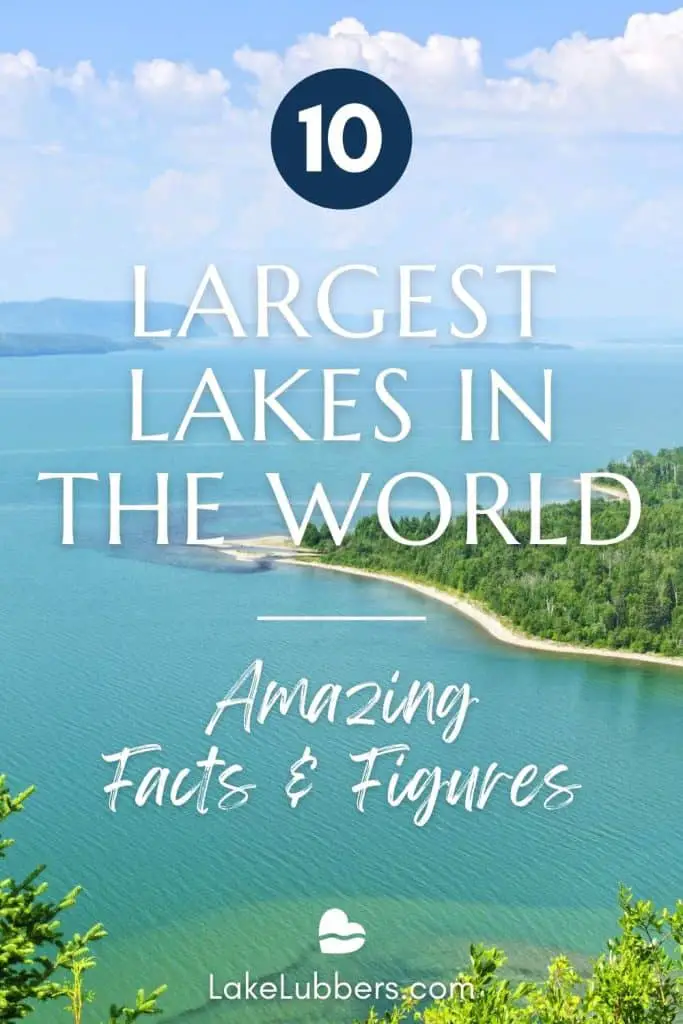
1 – Caspian Sea
The Caspian Sea is the largest lake on Earth by both volume and surface area. Size estimates range from 92 million acres to almost 108 million acres (374,000 to 436,000 square kilometers)!
Many classify this body of water as an inland sea instead of a lake because of its high salinity and geological history.
The Caspian Sea is a terminal lake, meaning that it has no natural outlet. Water levels are determined by inflow from more than 130 rivers, with 80 percent of the water coming from Russia’s Volga River.
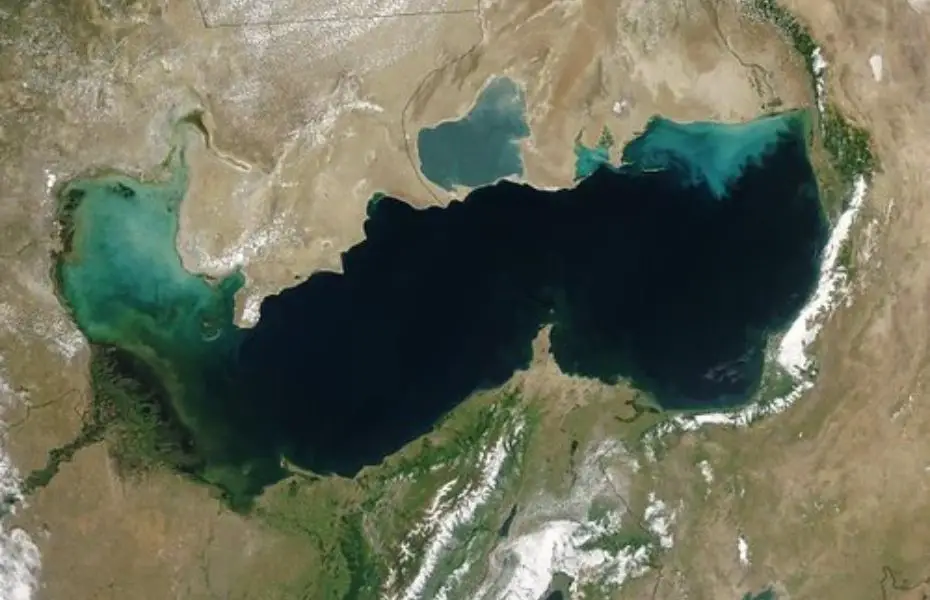
The Caspian Sea sits atop some of the world’s largest oil and natural gas reserves, and holds about 90 percent of the world’s prized sturgeon reserves (think caviar).
Bordering five countries – Azerbaijan, Iran, Kazakhstan, Russia, and Turkmenistan – the Caspian Sea offers unforgettable adventures and travel opportunities.
The shores of the Caspian Sea have excellent beach clubs, from the Absheron Peninsula resorts easily reached from Baku to the water sports center of Shuraabad.

2 – Lake Michigan-Huron
Although Lake Michigan and Lake Huron are usually classified as two separate North American Great Lakes, they are actually a single body of water – hydrologically speaking – connected by the five-mile wide Straits of Mackinac.
Combined, Lake Michigan-Huron is the world’s largest freshwater lake, measured by its combined surface area of about 29 million acres (117,700 square kilometers), surpassing Lake Superior’s 20.3 million acres.
If considered separately, Lake Huron and Lake Michigan are the world’s third and fourth largest freshwater lakes, covering about 14.7 million acres and 14.3 million acres, respectively.
Sandy beaches, scenic lighthouses, historic Mackinac Island, water sports galore, and incredible sunsets provide the makings of a perfect vacation.

3 – Lake Superior
If Lake Michigan and Lake Huron are considered separate lakes, Lake Superior reigns as the largest freshwater lake on Earth by surface area, covering nearly 20.3 million acres (82,400 square kilometers).
Skipping over state and country borders, Lake Superior is the largest, deepest, coldest, least developed, and most pristine of the Great Lakes.
The majesty of its waters and its national parks (Isle Royale National Park, Pictured Rocks National Lakeshore, Apostle Islands National Lakeshore, Grand Portage National Monument) provide year-round vacation opportunities.
The indigenous Ojibwe tribes called the lake ‘Gichigami,’ meaning “big water,” immortalized as ‘Gitche Gumee’ in Henry Wadsworth Longfellow’s ‘The Song of Hiawatha.’ And big water it is, sinking thousands of ships when storms turn a placid Lake Superior into a menacing body of water rivaling the world’s oceans.

4 – Lake Victoria
Lake Victoria garners two superlatives: it is the largest lake on the African continent by surface area and the largest tropical lake in the world, covering more than 17 million acres (69,500 square kilometers).
Lake Victoria is one of the seven “African Great Lakes,” extending into three countries: Kenya (6%), Uganda (45%), and Tanzania (49%).
International water travel is not permitted on Lake Victoria, so most visitors reach it by safari – traveling through beautifully scenic national parks with vast wildlife populations – to the lake’s shoreline and islands.
Lake Victoria forms the headwaters of the great Nile River, as confirmed by American explorer Henry Morton Stanley in 1871. His meeting with explorer David Livingstone in Tanzania is immortalized in the words, “Dr. Livingstone, I presume?”

5 – Lake Tanganyika
Lake Tanganyika is the second largest of the African Great Lakes, at just half the size of Lake Victoria.
With 7.9 million acres (32,800 square kilometers), it is also the second deepest lake in the world – 4,708 feet from its surface to its bottom. It is the longest freshwater lake in the world (420 miles), crossing the borders of four countries: Burundi, Zambia, Democratic Republic of Congo, and Tanzania.
Like Lake Victoria, Lake Tanganyika was first brought to the attention of Europeans in the mid-19th century when English explorers were trying to find the source of the Nile River, the world’s longest river.
Lake Tanganyika’s shoreline ranges from vertical cliffs soaring up to 6,500 feet, to secluded coves and sandy beaches. Surrounding national parks in Zambia and Tanzania teem with wildlife, including water buffalo, zebras, elephants, lions, leopards, crocodiles, and birds, all of which come to the water’s edge for a cool drink.

6 – Lake Baikal
Lake Baikal is Russia’s national treasure, spanning almost 7.8 million acres (31,500 square kilometers).
Lake Baikal claims three lake superlatives. It is the world’s deepest lake at 5,314 feet deep, including some points that are more than 3,800 feet below sea level. It is the largest freshwater lake measured by water volume, with about 20% of Earth’s unfrozen surface freshwater. It is also the world’s oldest lake, estimated at 25 million years.
Lake Baikal is one of the most biologically diverse lakes on Earth, home to at least 1,500 animal species and 1,000 plant species. Many of these species are endemic, found only at Lake Baikal, including freshwater seals known as nerpas.
It’s no wonder that tourism is on the rise, focused on its surrounding forests, majestic mountains, waterfalls, warm weather boat tours, hiking, and Lake Baikal’s excellent fishing and hunting.
Preservationists are constantly vigilant against many threats; Lake Baikal’s future will depend on the Russian government’s commitment to preserve and protect this uniquely valuable world resource.

7 – Great Bear Lake
Located on the Arctic Circle in Canada’s Northwest Territories, Great Bear Lake is the largest lake completely contained within Canada’s borders.
With an area of 7.7 million acres (31,150 square kilometers) and more than 26 islands, Great Bear Lake is an outdoor utopia for visitors who seek the peace and quiet of a large, pristine lake. Magnificent scenery is the norm, especially in the MacTavish Arm of the Lake.
The only village on Great Bear Lake is Deline, with 600 residents. ‘Fly in’ is the mode of transportation; air travel to the lake is possible nine months of the year.
Wildlife viewing, fishing, and hunting are so plentiful on this lake surrounded by wilderness that caribou must sometimes be chased from the Deline Airport before incoming planes can land!
Great Bear Lake holds world records for lake trout and arctic grayling. Ice fishing is popular since the lake is frozen for about eight months each year.

8 – Lake Malawi / Lake Nyasa
Lake Malawi is the third largest of the African Great Lakes, extending more than 7.3 million acres (30,000 square kilometers) along the borders of three countries: Malawi, Mozambique, and Tanzania.
British explorer David Livingstone reached the lake in 1859, naming it Lake Nyasa and giving it the nickname “Lake of Stars” in reference to the fishermen’s lanterns at night. Today, the lake’s name is still in dispute, with some countries calling it Lake Malawi and others calling it Lake Nyasa.
The lake’s tropical waters contain one of the greatest numbers of fish species on earth, including colorful cichlids that are popular in aquariums.
Lake Malawi’s two inhabited islands, Likoma and Chizumulu, are famous for their abundance of Baobab trees. Stunning scenery, beautiful beaches, and enticing African wildlife await you here.

9 – Great Slave Lake
Great Slave Lake is the second largest lake in Canada, covering 6.7 million acres (28,900 square kilometers). It is the deepest lake in North America, plunging to more than 2,000 feet below its surface.
This sub-arctic lake in Canada’s Northwest Territories is frozen for about five months of the year, so ice fishing, dog sledding, and snowmobiling expeditions are popular. Yellowknife, the capital city of the Northwest Territories, sits on the lake’s northern shore.
The terrain of this irregularly-shaped glacial lake ranges from flat channels of the Slave River Delta, to rocky islands of the North Arm, and to tall red granite cliffs of the East Arm. The 125-mile East Arm invites exploration by canoe or kayak.
Late summer offers good weather, vibrant autumn colors, and the southward migration of waterfowl. The Northern Lights are spectacular from late November through mid-April.

10 – Lake Erie
Completing our World’s 10 Largest Lakes list is Lake Erie, covering 6.3 million acres (25,700 square kilometers) and straddling four U.S. states and one Canadian province.
Lake Erie is the shallowest of the Great Lakes, reaching (at its deepest points) to about 200 feet below its surface. These relatively shallow depths create great angling opportunities, garnering its nickname “The Walleye Capital of the World.”
Lake Erie contains more than 30 islands, including Presque Isle. Pennsylvania’s Presque Isle State Park has a beautiful coastline with 7 miles of protected, sandy beaches.
Ohio state parks are located on five more islands: Catawba Island, Kelleys Island, South Bass Island, Middle Bass Island, and North Bass Island.
Lake Erie provides a wealth of recreation options, both on and off the water: boating, sailing, wildlife viewing, island hopping, caving, visiting lighthouses, a wildlife park, city zoo, and an amusement park.

The Great Lakes: Cool Facts and Figures for Kids (and Adults!)
The Great Lakes consist of five lakes (plus a smaller attached one named Lake St. Clair) that are all located in the same area of North America, specifically in the mid-upper area…
